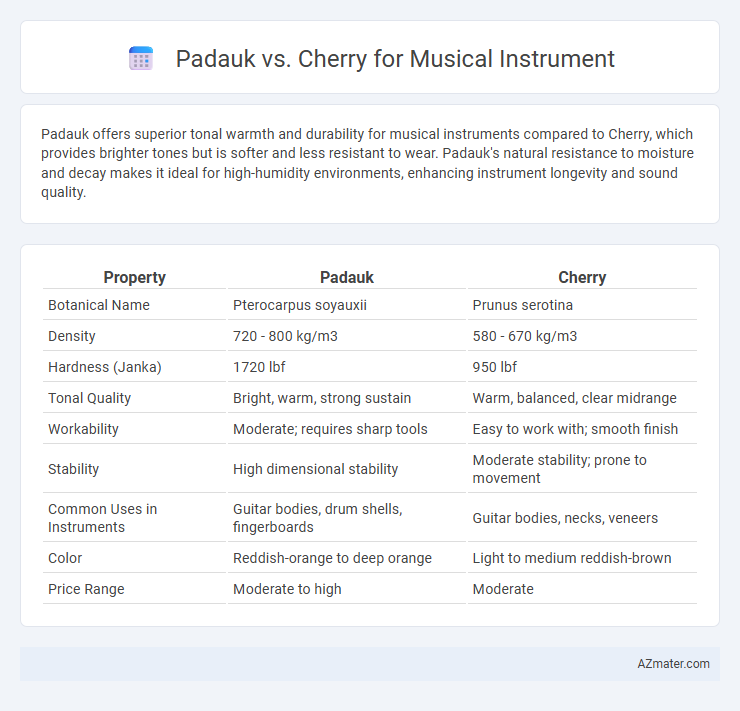Padauk offers superior tonal warmth and durability for musical instruments compared to Cherry, which provides brighter tones but is softer and less resistant to wear. Padauk's natural resistance to moisture and decay makes it ideal for high-humidity environments, enhancing instrument longevity and sound quality.
Table of Comparison
| Property | Padauk | Cherry |
|---|---|---|
| Botanical Name | Pterocarpus soyauxii | Prunus serotina |
| Density | 720 - 800 kg/m3 | 580 - 670 kg/m3 |
| Hardness (Janka) | 1720 lbf | 950 lbf |
| Tonal Quality | Bright, warm, strong sustain | Warm, balanced, clear midrange |
| Workability | Moderate; requires sharp tools | Easy to work with; smooth finish |
| Stability | High dimensional stability | Moderate stability; prone to movement |
| Common Uses in Instruments | Guitar bodies, drum shells, fingerboards | Guitar bodies, necks, veneers |
| Color | Reddish-orange to deep orange | Light to medium reddish-brown |
| Price Range | Moderate to high | Moderate |
Introduction to Padauk and Cherry Woods
Padauk wood, known for its vibrant reddish-orange hue and natural durability, offers excellent tonal qualities and resistance to wear, making it popular in musical instrument construction. Cherry wood features a fine, uniform grain and warm reddish-brown color that deepens with age, providing smooth resonance and a balanced sound profile favored in acoustic instruments. Both woods deliver unique aesthetic and acoustic properties that influence instrument performance and visual appeal.
Origin and Availability of Padauk and Cherry
Padauk originates primarily from tropical Africa and Southeast Asia, with species like African Padauk (Pterocarpus soyauxii) widely available in these regions, offering dense, resilient wood ideal for musical instruments. Cherry wood, mainly sourced from North America and Europe, comes from the Prunus genus, known for its smooth grain and warm tonal properties crucial for guitars and violins. Availability of Padauk can be more limited and subject to regional forestry regulations, whereas Cherry is generally more accessible due to sustainable harvesting and widespread growth in temperate climates.
Physical Characteristics and Appearance
Padauk exhibits a vibrant reddish-orange hue that deepens with age, providing a striking aesthetic for musical instruments, while Cherry wood offers a warm, rich reddish-brown color that darkens gracefully over time. Padauk has a coarse, open grain with moderate hardness and excellent dimensional stability, making it resistant to warping and ideal for instrument components requiring durability. Cherry features a fine, straight grain with a smooth texture and moderate hardness, offering ease of shaping and a classic appearance favored for guitars, violins, and other stringed instruments.
Tonal Properties and Sound Quality
Padauk offers a bright, warm tone with strong midrange presence, providing excellent resonance and sustain favored for guitar bodies and drum shells. Cherry wood delivers a balanced, clear sound with a smooth, rounded tonal profile, often chosen for its natural warmth and midrange clarity in string instruments. Both woods enhance sound quality by offering stability and distinct tonal characteristics, with Padauk emphasizing vibrant projection and Cherry emphasizing warmth and sweetness.
Workability and Ease of Crafting Instruments
Padauk offers excellent workability due to its moderate density and fine grain, making it relatively easy to shape and sand for musical instruments. Cherry wood, appreciated for its smooth texture and consistent grain, allows precision crafting and finishes well, enhancing tonal quality in instruments. Both woods are favored for their natural stability, but Padauk's durability and resistance to wear provide an edge in long-lasting instrument construction.
Durability and Longevity in Instruments
Padauk wood offers exceptional durability and resistance to wear, making it ideal for musical instruments that require long-lasting performance and stability under stress. Cherry wood, while appreciated for its warm tone and fine grain, is softer and more prone to dents and scratches, potentially affecting the instrument's longevity. Instruments crafted from Padauk tend to maintain structural integrity and sound quality over extended periods, outperforming Cherry in terms of durability and lifespan.
Cost Comparison: Padauk vs Cherry
Padauk wood typically costs more than cherry due to its vibrant color and durability, making it a premium choice for musical instruments. Cherry wood offers a more affordable option while still providing a warm tone and good workability, favored in mid-range instruments. Musicians and luthiers often weigh the higher price of Padauk against its striking appearance and acoustic qualities compared to the budget-friendly, versatile cherry.
Popular Instruments Made from Padauk and Cherry
Padauk wood is widely favored for guitars and ukuleles due to its vibrant reddish-orange hue and strong tonal resonance, offering bright, ringing sound qualities preferred by many luthiers. Cherry wood, commonly used in violins and acoustic guitars, provides a warm, balanced tone with excellent sustain and a smooth, rich grain ideal for instrument bodies and necks. Both woods contribute unique aesthetics and acoustic properties, with Padauk excelling in tropical hardwood durability and Cherry prized for its versatile tonal warmth.
Environmental Impact and Sustainability
Padauk wood exhibits moderate sustainability due to its rapid growth and availability from well-managed tropical forests, reducing environmental strain compared to rarer hardwoods like Cherry. Cherry wood, predominantly sourced from temperate regions, often faces slower regeneration rates, increasing the risk of overharvesting and habitat disruption. Choosing Padauk for musical instruments promotes eco-friendlier practices by leveraging faster renewable resources while minimizing deforestation impacts associated with traditional Cherry wood.
Choosing the Right Wood for Your Musical Instrument
Padauk offers vibrant red hues and excellent stability, making it ideal for instruments requiring both durability and aesthetic appeal. Cherry provides warm tones and smooth grain patterns, enhancing sound resonance and visual elegance in stringed instruments. Selecting between Padauk and Cherry depends on balancing tonal qualities with durability and color preference for your musical instrument project.

Infographic: Padauk vs Cherry for Musical Instrument
 azmater.com
azmater.com